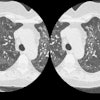AJR Am J Roentgenol 1997 Sep;169(3):661-666
Routine addition of an automated biopsy device to fine-needle aspiration of the lung: a prospective assessment.
Boiselle PM, Shepard JA, Mark EJ, Szyfelbein WM, Fan CM, Slanetz PJ, Trotman-Dickenson B, Halpern EF, McLoudTC
Department of Radiology, Massachusetts General Hospital, Boston 02114, USA.
OBJECTIVE: The purpose of this study was to prospectively assess the usefulness of the routine addition of an automated biopsy device (ABD) to fine-needle aspiration (FNA) of the lung and to examine the complication rate of this procedure.
SUBJECTS AND METHODS: Fifty biopsies were performed under CT guidance using a coaxial technique with a 19-gauge introducer needle and a 22-gauge aspirating needle followed by a 20-gauge ABD. An average of 3.5 FNA specimens and 2.5 core specimens were obtained. Cytology and histology specimens were interpreted separately by two experienced pathologists who were unaware of the other's interpretation. Final diagnoses were based on surgery, microbiology, definitive biopsy diagnosis, and clinical follow-up. All complications were recorded. RESULTS: Of 34 malignant lesions, we achieved a diagnostic accuracy of 94% for FNA and 59% for core biopsy (p < .01). Combined accuracy was 94%. Of 16 benign lesions, an accurate definitive diagnosis was made in 31% of cases using FNA and in 69% of cases using core biopsy (p = .08). Combined accuracy was 69%. In the subset of benign lesions that were not acute infections (n = 8), an accurate definitive benign diagnosis was made in 12% of cases using FNA and in 75% of cases using core biopsy (p < .05). No false-positive diagnoses of malignancy occurred. Complications included pneumothorax, nine (18%) of 50 cases; chest tube, one (2%) of 50 cases minor pulmonary hemorrhage, seven (14%) of 50 cases; and minor hemoptysis, two (4%) of 50 cases. CONCLUSION: The complication rates of FNA with the addition of an ABD are similar to those reported in the literature for FNA alone. The addition of an ABD significantly increases the diagnostic accuracy only for the subset of benign lesions that are not acute infections.
PMID: 9275873, MUID: 97421756







